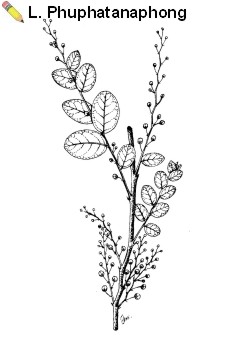Record Number
1416
PROSEA Handbook Number
3: Dye and tannin-producing plants
Taxon
Phyllanthus reticulatus Poiret
Protologue
Lamk, Encycl. Méth. Bot. 5: 298 (1804).
Family
EUPHORBIACEAE
Chromosome Numbers
2n = 26
Synonyms
Phyllanthus multiflorus Willd. (1805), Kirganelia reticulata (Poiret) Baillon (1858).
Vernacular Names
Indonesia: wawulutan (Sundanese), trembilu, congcong belut (Javanese). Malaysia: tampal besi, kayu darah belut. Philippines: malatinta (Tagalog), matang-buiud (Bikol), sungot-olang (Bisaya). Cambodia: prâpéénh chhmôôl. Laos: 'am 'aiz, kang paax. Thailand: kaang plaa khruea (general), mat kham (Phrae), am aai (Nakhon Ratchasima). Vietnam: phèn den.
Origin and Geographic Distribution
Phyllanthus reticulatus is found throughout the Old World tropics. In Asia it is widely distributed from India and Sri Lanka to southern China and eastern Malesia (Irian Jaya), including the whole of South-East Asia. This species is also widespread in tropical Africa.
Uses
A black ink is prepared in the Philippines from the ripe fruits. In Indonesia a decoction of stems and leaves was used for dyeing cotton black. It is also used as a mordant. In India the root is reported to produce a red dye.
Phyllanthus reticulatus has numerous medicinal uses. Roots, bark, leaves, as well as fruits are used for a large number of complaints, notably to treat asthma and coughs, and for injuries of the skin. The wood is sometimes used to make utensils.
Phyllanthus reticulatus has numerous medicinal uses. Roots, bark, leaves, as well as fruits are used for a large number of complaints, notably to treat asthma and coughs, and for injuries of the skin. The wood is sometimes used to make utensils.
Properties
Very little is known about the phytochemistry of Phyllanthus reticulatus. The plant contains tannic acid which is partly responsible for its medicinal and dyeing properties. A number of triterpenoids including sitosterol, friedelin, and betulinic acid have been demonstrated in the stems and leaves.
The wood is hard and tough, and greyish-white to reddish.
The wood is hard and tough, and greyish-white to reddish.
Botany
A monoecious scandent shrub or small bushy tree, up to 5 m tall (in Africa rarely up to 18 m tall); trunk up to 15 cm in diameter, bark rough, brown to grey, branchlets slender. Leaves differently shaped; spirally arranged scale-like, ca. 1.5 mm long on the orthotropic shoots; plagiotropic shoots with normally developed, distichous, elliptic to (ob)ovate leaves, 1—3(—5) cm x 0.5—2(—2.5) cm, entire, cuneate to rounded at base, obtuse to emarginate at apex, glabrous and shortly petiolate. Flowers in few-flowered fascicles or solitary in leaf axils, unisexual, often a single female flower and some male flowers together, sometimes arranged on leafless shoots and those then seemingly long racemes, with 5(—6) perianth lobes and 5(—6) disk glands; male flowers with 5(—6) stamens; female flowers with a superior subglobose ovary, crowned by 2-lobed styles. Fruit a depressed-globose berry, up to 7 mm in diameter, usually blueish-black when ripe with dark purplish pulp, 6—many-seeded. Seeds trigonous, up to 2 mm long, blackish.
Phyllanthus reticulatus generally flowers throughout the year. The indumentum of leaves, stems and flowers is variable, from glabrous to densely pubescent. In Africa, 2 varieties have been distinguished: var. reticulatus with pubescent flowering shoots and sometimes also leaves and stems, and var. glaber (Thwaites) Muell. Arg. with all parts glabrous.
Phyllanthus reticulatus generally flowers throughout the year. The indumentum of leaves, stems and flowers is variable, from glabrous to densely pubescent. In Africa, 2 varieties have been distinguished: var. reticulatus with pubescent flowering shoots and sometimes also leaves and stems, and var. glaber (Thwaites) Muell. Arg. with all parts glabrous.
Image
 | Phyllanthus reticulatus Poiret - flowering branch |
Ecology
Phyllanthus reticulatus frequently grows along watercourses, but also in scrub and hedges, on waste places, and in mixed evergreen forest. It is found in India and Taiwan up to 2000 m altitude. In Malesia it is usually confined to the lowlands, up to 800 m. This species is often common in moist places.
Prospects
Very little is known about this plant. Chemical analysis is needed to elucidate the interesting dyeing and medicinal properties of this extremely widespread species.
Literature
Backer, C.A. & Bakhuizen van den Brink, R.C., 1963. Flora of Java. Vol. 1. Noordhoff, Groningen, the Netherlands. p. 467.
Crevost, Ch. & Pételot, A., 1941. Catalogue des produits de l'Indochine. Tome 6. Tannins et tinctoriaux. Gouvernement général de l'Indochine, Hanoi. p. 72 + fig.
Dalziel, J.M., 1936. The useful plants of West Tropical Africa. Crown Agents for Oversea Governments and Administrations, London. p. 158.
Sastri, B.N. (Editor), 1959. The wealth of India. Raw materials. Vol. 5. Council of Scientific and Industrial Research, New Delhi. pp. 320—321.
Crevost, Ch. & Pételot, A., 1941. Catalogue des produits de l'Indochine. Tome 6. Tannins et tinctoriaux. Gouvernement général de l'Indochine, Hanoi. p. 72 + fig.
Dalziel, J.M., 1936. The useful plants of West Tropical Africa. Crown Agents for Oversea Governments and Administrations, London. p. 158.
Sastri, B.N. (Editor), 1959. The wealth of India. Raw materials. Vol. 5. Council of Scientific and Industrial Research, New Delhi. pp. 320—321.
Author(s)
L. Phuphathanaphong
Correct Citation of this Article
Phuphathanaphong, L., 1991. Phyllanthus reticulatus Poiret. In: Lemmens, R.H.M.J. and Wulijarni-Soetjipto, N. (Editors): Plant Resources of South-East Asia No 3: Dye and tannin-producing plants. PROSEA Foundation, Bogor, Indonesia. Database record: prota4u.org/prosea

All texts are licensed under a Creative Commons Attribution-Noncommercial-Share Alike 3.0 Netherlands License
This license does not include the illustrations (Maps,drawings,pictures); these remain all under copyright.